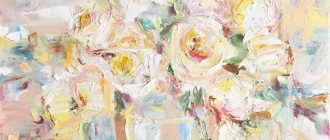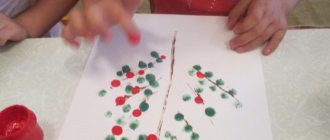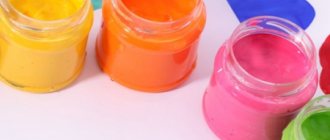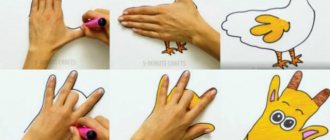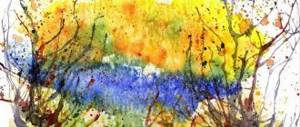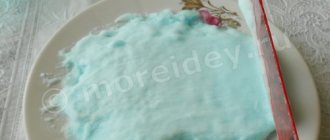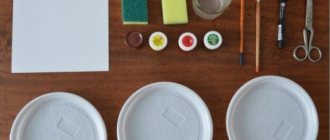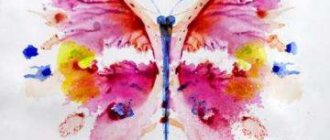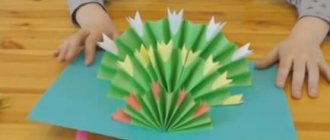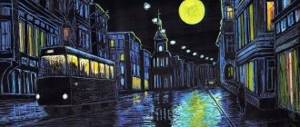Among the various non-traditional techniques of fine art, one stands out - drawing with crumpled paper. It is notable for its simplicity of execution and is suitable for classes with the youngest artists. Each print is unique and different from others. The technique allows you to obtain images of flowers, trees, clouds, sun, butterflies.
The benefits of learning non-traditional drawing techniques
Drawing with a brush and pencils requires certain knowledge, experience, and precise hand movements. In preschool children, these skills have not yet been developed. Unsuccessful attempts to get a beautiful image quickly turn kids away from creative activities. Conversely, successful drawing evokes delight and a desire to improve. Non-traditional drawing tools are easier to learn.
Learning different techniques brings invaluable benefits to children:
- increases interest in creative activities;
- teaches attention to detail;
- stimulates curiosity;
- develops creative abilities;
- promotes extraordinary thinking;
- trains hand motor skills;
- improves perseverance;
- provides an opportunity to express emotions and embody creative ideas.
It is useful to master non-traditional means of drawing at home and in kindergarten (middle group, preparatory, senior). To obtain a design, use crumpled paper, toothbrushes, plasticine, salt, soap bubbles, vegetables and other available items.
Who is this technique suitable for?
Professionals often turn to this technique; the relevance of the “drawing with crumpled paper” method cannot be underestimated in the world of modern painting. However, self-taught amateurs can successfully develop their skills in this painting technique. It's never too late to start drawing! Moreover, for the youngest artists this method is an excellent opportunity to develop fine motor skills and learn something new, instilling a love of art. Thanks to this interesting and even funny way of drawing, the baby will be able to better distinguish and remember colors, and create bright images with the help of their parents. So, for example, very often young children are helped in creating a picture in the following way: they draw a thick outline of a bright color and ask the child to carefully fill it in using crumpled paper.
How to draw with crumpled paper?
It is recommended to conduct drawing lessons for children in a playful way. Having chosen the theme of the drawing, it is advisable to prepare material on it: poems, riddles, pictures, songs. In kindergarten, a fascinating presentation will help start the lesson, for example, about winter, if the theme of the drawing is a winter landscape.
Necessary materials for drawing with crumpled paper:
- paints (watercolor, pastel, gouache);
- disposable plates or shallow containers for paint;
- a sheet of paper - white or colored;
- A4 sheets cut into 4 parts and crumpled;
- brush and glass of water.
Technique for drawing with crumpled paper:
- Paints of the desired colors are placed in shallow plastic containers.
- Pieces of paper approximately 15 by 10 cm are crumpled in random order. For each color - one crumpled piece of paper.
- The crumpled paper acts as a brush. You need to saturate it with paint and leave an imprint.
The impression can be placed pointwise. Or you can draw lines with pieces of paper (sky, grass, sea waves). Young children 2–3 years old can fill out coloring pages in this way.
When using thick paint, the image will turn out textured. With liquid paint, prints come out translucent and airy.
Drawings using the crumpled paper technique are characterized by loose lines and a certain abstractness. To get a realistic image, it is recommended to use a brush and pencil, using them to fill in the details - for example, a tree trunk, leaves, flower stems.
Example pictures:
What tools and materials will be needed for the job?
To draw with crumpled paper you will need:
- sketchbook;
- gouache or watercolor (the latter is preferable because it dissolves better in water and creates softer color transitions);
- small vessels for drawing. You need as many of them as the colors you plan to use. Disposable tableware and even toy sets are also suitable;
- soft paper or napkins.
Important! There is no need to use newspapers for drawing, since printing ink, when wet, can leave unwanted marks on the drawing.
Since the set of tools needed to complete the process is very small, the technique can be used not only by kindergarteners, but also by primary school students, as well as by all those who want to use something new and unusual in their creative process.
Master class on drawing lilacs
Painting lilac flowers with just one brush is an impossible task for a child. With crumpled paper you can get an image of inflorescences much faster and easier.
Master Class:
- Sketch twigs and leaves in the shape of hearts on paper with a pencil. Mark the inflorescences.
- Using a brush and brown paint, draw a twig, and green leaves.
- Crumple up a small piece of paper and dip it into a container of blue paint. Make several prints where the inflorescence should be located.
- Take new crumpled paper and purple paint. Make prints over the blue prints.
- The last thing you need to do is make prints with white paint. This way the flowers will look three-dimensional and realistic.
Children's works:
Crumpled paper is one of the most accessible non-traditional drawing media. It replaces a brush perfectly. The tracks are intricate, unique, and chaotic, which is what attracts the attention of viewers. By using your imagination, you can create a chiaroscuro, textured image. This type of unconventional drawing is useful for both young and experienced artists. Happy creativity!
Why drawing with crumpled paper?
Landscape, still life and even portrait – all these genres of painting can be performed using different techniques. Drawing techniques with crumpled paper open up a huge scope for imagination, allow you to experiment and learn something new day after day. As mentioned above, this type of drawing is useful not only for experienced artists, but also for very young masters who are just starting their creative path. It is this drawing technique that can be an excellent start for the development of a child’s talent. A painting made in this style is filled with an indescribable atmosphere of lightness and airiness and can decorate any interior.
Creative materials
Paper is the most important element of this style of drawing. Select paper based on its density and structure, depending on what result you want to achieve in the end. Its different types allow you to create different textures of the picture. Whatman paper and any other type of paper can serve as your canvas. Use disposable dishes (flat plates) to mix colors. In order to create a painting using this technique, you don’t need to choose any specific paints, and you practically won’t need brushes, so you don’t have to worry about choosing brushes either. Watercolor, pastel or gouache - the choice is yours! In order for the painting to be as voluminous as possible, the paint will need to be heavily diluted with water; artists advise using warm water. There is no single formula for the “correct” drawing with crumpled paper; on the contrary, every artist has the right to draw as he sees fit. Having understood a little about the general steps of this method, you will easily master drawing with crumpled paper and will be able to complement this technology with your own inventions with each new drawing.
Stages of work completion
Step-by-step instruction:
- Take several sheets of paper and crumple them into lumps.
- On slightly damp paper, mark the main color (this will be the background).
- Dip the crumpled paper into containers of paint of the desired color and press them briefly onto the sheet.
- Continue working until the image turns out the way it was originally intended.
- With the help of paints and a brush, you can define clearer contours or complement the drawing.
Modern easy beautiful dances for girls
How to draw crumpled paper? Tips for beginning artists
Hello everyone who wants to learn how to draw! Today we will look at how to draw crumpled paper.
As you probably already know, I teach some students via the Internet. Recently I asked one girl to draw a sheet of crumpled paper with a pencil. That's what came out of it.
On the left we see her drawing, and on the right are photographs of the sheet of paper that she drew.
The girl undoubtedly put a lot of effort into the drawing. You can see how all the details that could only be noticed have been worked out. I liked the neatness of the drawing. It is clear that she tried to stroke carefully, she wanted to draw every curve of this sheet. It is commendable! Keep it up!
Now let's talk about the things that didn't work very well in this drawing.
Well, first of all, the paper is depicted a bit large. There should be more space around the edges, especially at the bottom.
Secondly, the work looks fractional. Why is this happening ?
This is one of the most common mistakes novice artists make. The work lacks integrity when the artist excessively draws details without paying attention to the overall shape of the object being drawn. In this case, it was necessary to show the general shape of the crumpled sheet and indicate the shadow and light parts.
To do this, you need to remember the theory of chiaroscuro in drawing. From the photograph sent you can see that the light falls on the right, and the shadow falls on the paper on the left. In the figure, the light and shadow areas are located almost chaotically. It was necessary to draw the shadow with a general spot, the same applies to the light. Now the shadow is crumbling into small pieces. If we carefully read books on drawing (specifically the chapter on chiaroscuro), we learn that reflections in the shadow should be darker than the light on the object. In this case, the left side of the crumpled paper is shadow, so it cannot have such light areas.
Guys, don’t be lazy, read books on drawing and make more sketches, otherwise you’ll keep coming across hackneyed mistakes!
In addition, I want to give a little advice: when you have finished your work, move away from it for some distance to catch mistakes. If the author of this drawing looked at her from afar, she would want to combine the shadow with large strokes and strengthen it (make it darker at the junction with the light).
To be honest, the work is not bad, it’s just not finished!
Maybe the girl is tired, or maybe she just doesn’t know that the work can still be completed for a long time. This is a pencil, you can apply many layers and erase what you don’t like. This is a very flexible technique, unlike other materials (watercolor for example)! So take the flag in your hands and finish the crumpled paper
